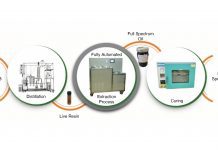
Leafcann Group examines the potential of the UK medicinal cannabis market using an Australian case study.
The UK medicinal cannabis sector is at a crucial point in its evolution. The increasing interest in the potential of these medicines has led to more listings on British-based stock exchanges, with more expected to list soon. Investor confidence is increasing, as is the interest from potential patients who are looking for an alternative approach to treating conditions which are not responding to traditional medicine.
The first half of 2021 represents an important period for the medicinal cannabis sector in the UK. At one end of the spectrum, is the announcement in 2020 by the European Commission that it is pausing all pending applications by cannabidiol (CBD) products for novel food authorisation, while at the other end we have the tabling of a report, with recommendations, on the assessment of the impact of rescheduling cannabis-based products for medicinal use (CBPMs) to Schedule 2 under the Misuse of Drugs Regulations 2001 (MDR). Decisions will need to be made on how the UK can respond to these opportunities.
Despite the success of UK-produced products such as Sativex and Epidyolex, the UK remains bogged down with regulatory hurdles that continue to stifle the industry and prevent more patients from accessing unregistered medicinal cannabis products. It is extremely difficult to access medicinal cannabis if you are not going through the private health system.
The situation in the UK in 2021
The UK has issued only a handful of NHS CBPM prescriptions for patients since rescheduling in November 2018, despite all NHS specialist physicians being legally permitted to prescribe. In the meantime, thousands of scripts have been written via the private system, with high non-reimbursable costs for appointments and assessments, and medicines for which no Consumer Medical Information or Certificate of Analysis are provided, leaving patients wondering what they are paying for. The only exceptions to these restrictions are the drugs Sativex, licensed for spasticity associated with multiple sclerosis, Epidyolex, for certain childhood epilepsies when prescribed alongside Clobazam, and a synthetic cannabis medicine called Nabilone, for chemotherapy induced nausea and vomiting.
Meanwhile millions of Britons are using CBD purchased at their local pharmacy, health food store, or online. The status of many of these products will be uncertain after 31 March this year, when all CBD preparations sold in the UK will require Novel Foods registration. This entails preparation of a safety dossier for each medicine costing hundreds of thousands of pounds. Regardless, most commercially available CBD preparations in the UK are not high dose and therefore generally not suitable for the treatment of serious conditions, although many patients report benefit in their usage for conditions like migraines, aches and pains, low grade insomnia, arthritis, and low, general anxiety.
Between 2017 and 2019, at least 800 patients a year received the UK’s three licensed cannabis products; Epidyolex, Nabilone, and Sativex, although that number continues to increaseevery year. The number of private UK patients is now estimated to be around 6,000, however, less than five patients have been prescribed unlicensed CBPMs through the National Health Service (NHS), despite the growing interest and continued pressure being maintained by patient advocacy groups for those who cannot afford private health coverage. The main justification for not prescribing medicinal cannabis is the claim that there is a lack of safety and efficacy data for many of the unlicensed CBPMs, despite CBPMs being specifically down-scheduled by the government for just this purpose under its authorised prescriber special access scheme. Prescribing unlicensed CBPMs is limited to specialists on the register of the General Medical Council.
An opportunity for change
The UK’s Advisory Council on the Misuse of Drugs (ACMD) published its assessment on the impact of the rescheduling of CBPMs in November 2020. The report recommended: further reviews of the system; the impact of the rescheduling of CBPMs; the creation of a CBPM registry so that prescription patterns could be monitored; and that reviews be conducted of other international approaches to legislating medicinal cannabis access and use.
The review of international approaches is a wise decision, and not just because it might provide the best way forward, but also because it enables the UK to learn from the mistakes of other jurisdictions and avoid wasting time with an inefficient system. The Australian experience provides a wealth of information and experience that should be examined more closely.
The situation in Australia
In Australia medicinal cannabis products must be prescribed either via the Special Access Scheme (SAS) Category B, or via the Authorised Prescriber scheme. Any health professional capable of prescribing medication can use the SAS online portal to prescribe medicinal cannabis. Becoming an Authorised Prescriber requires a separate application in which the prescriber, once approved, will be able to freely prescribe one product for one condition. Although this is restrictive, the healthcare provider does not need any further approval to prescribe that medication. The Australian Government is currently reviewing options for the Authorised Prescriber process to make it less restrictive.
From legalisation of medicinal cannabis in 2016 to late 2019, very few scripts had been written. Once the States and Commonwealth government began to streamline the authorisation application and assessment process, approvals started to climb. The Therapeutic Goods Administration (TGA) recently announced it had authorised its 100,000th prescription for a medicinal cannabis product. Most of these scripts have been approved within 48 hours of the request being submitted electronically. February alone saw more than 8,000 scripts approved; a jump from the average 5,000 scripts per month that had been approved the previous year. It is estimated that between 45,000 to 65,000 patients are currently using medicinal cannabis through the Special Access Scheme.
By comparison, there are just under 200 Authorised Prescribers who authorised over 2,000 prescriptions in 2020. The number of prescribers and prescriptions has increased markedly over the last 12 months. Each Authorised Prescriber can write hundreds or thousands of scripts each month.
New legislation, as of 1 February 2021, means low dose CBD has been down scheduled to Schedule 3 in Australia, meaning it can be dispensed by a pharmacist, provided it is a registered medicine. To date, no low-dose CBD products have been registered due to the extensive requirements for registering a medicine in Australia. This will require further research, including Randomised Control Trials (RCT), which can take years in some cases. However, the TGA has indicated it is looking at the ability to recognise international data and high-level observational data towards registration.
The low dose CBD market is worth watching due to the high demand and current situation in the UK. Approximately 21% of medicinal cannabis patients in Australia are being prescribed low-dose CBD on a regular basis. This equates to about 10,000 patients who will be able to purchase their medicine over the counter at a pharmacy once they have consulted the pharmacist on duty. This will be a major improvement in access, while still ensuring that a health professional has had the opportunity to consult the client before purchase.
It should be noted that since the legalisation of over-the-counter CBD, there has been a jump in prescriptions and authorisations. This has been attributed to widespread media coverage of the down-scheduling of low-dose CBD to Schedule 3 over-the-counter dispensing, without a prescription. This has sent a signal to both the medical fraternity and patients that medicinal cannabis is safe and effective.
Another benefit of this widespread adoption of legalised medicinal cannabis usage is that the price of cannabis medicines has dropped significantly, and for the first time ever has reached parity with the illicit market, meaning that cannabis provided by the black market has no price advantage. The other contributing factor is that licensed medicinal cannabis companies are becoming more efficient in their production and distribution of these medicines to pharmacies. There are over 140 medicinal cannabis products available on the legal market in Australia. Recent announcements by the TGA suggests they will begin spot testing to ensure every product meets the Australian Therapeutic Goods Orders TGO93 and TGO100, that govern the standards under which medicinal cannabis products are produced.
The average patient spend on medicinal cannabis is AUS$50 per week (about £25 per week), whether from the licit or illicit market. This equates to $1.4bn being spent in the black market with just under $100m being spent via pharmacy. The Australian market is perhaps the fastest growing market in the world. Its growth has been recognised by government enterprises such as Commonwealth Scientific and Industrial Research Organisation (CSIRO) who are looking at developing new products types, such as cannabis cough lollies.
It is estimated that some half a million Australians currently use medicinal cannabis procured illegally to treat a medical condition. This number has dropped as more Australians move from the unregulated market to the regulated market, allowing for proper medical supervision of their illness and treatment with medicinal cannabis, which in turn provides the opportunity to gather valuable observational data for both their treating physicians and researchers, and increases the evidence base. The other benefit of prescription-based cannabis medication is its use in the treatment of opioid addiction, and the misuse of other drugs of dependence. This is a growing area of research in Australia.
“In 2018, opioids were present in nearly two-thirds of drug-induced deaths (64.5% or 1,123 deaths) — a rate of 4.6 per 100,000 population. Analysis by the ABS found that in almost two-thirds (63.1% or 708 deaths) of opioid-induced deaths, benzodiazepines were also present (ABS 2019). Many opioid-induced deaths were accidental (80%). The rate of opioid-induced deaths involving synthetic opioids has increased over the past decade (ABS 2019).1 By contrast, cannabis is implicated in about 30 deaths per year.2
To further underline this point 6,000 Australians died from alcohol use in 2015, with more than 144,000 hospitalisations in the years 2012 to 2013., remaining stable at 5.2 deaths per 100,000, up to and including 2017. Tobacco accounts for more than 15,500 deaths per year. When we compare safety profiles and access, it is ridiculous to consider medicinal cannabis presents any real risk to the public, as it accounts for 0.1 deaths per 100,000 in Australia.3
Lessons learned from the Australian experience
The Australian experience shows an obvious correlation between the jump in consumer interest and increases in media coverage. Promoting medicinal cannabis on authoritative websites, be they government or non-government organisations does not have the same effect as mainstream media and social media platforms. This is something that must be managed appropriately to ensure the right information is being passed on. Education of the general population is important if patients are to walk into a doctor’s surgery and confidently discuss medicinal cannabis options.
The uptake of medicinal cannabis by healthcare providers on the other hand is driven by evidence, authoritative research, and signals from governments that they are supported. The number of Australian doctors approving of medicinal cannabis as a treatment is increasing, albeit more slowly than the general public’s acceptance. Key to many doctors’ approval are the results from clinical trials and signals from the government in terms of new legislation. At present there are 73 clinical trial notifications in Australia. These are most commonly for chronic pain, epilepsy, and psychological disorders. More clinical trials are needed to add to the evidence base and improve confidence.
In terms of regulatory learnings, provision of an online prescribing portal at a national level has made prescribing easier, although there is still some room for improvement. Product-wise, a mandated level of GMP quality products has given confidence to prescribers that what they prescribe will be the same every time.
The way forward for the UK
In 2019, a research study survey in England and Wales found that 1.4 million people self-reported they were using ‘street’ cannabis to treat chronic health conditions, while over 60% said they spent between £99 and £199 a month on cannabis.4
Ann Keen, chair of the CPASS and fellow of the Queen’s Nursing Institute, said: “[The statistics] demonstrate the vast number of patients in the UK with chronic and debilitating diagnosed conditions who feel they have no choice but to expose themselves to all the risks of accessing a medicine that works from the criminal market.” Ms Keen added that “safe” solutions “must be explored as soon as possible.”4
Regulators often talk about the dangers of cannabis use, but even in the unregulated market, only 31 deaths were recorded in the UK in 2019. Contrast this with deaths from prescription medicines, particularly opioids, anti-anxiety drugs, sleeping tablets, tobacco, and alcohol: according to the Office of National Statistics (ONS), there were 4,359 deaths from drug poisoning in 2018. This is up 16% from the previous year and is the highest annual increase since records began in 1993.
Last year alone in the UK:
- 50 million prescriptions for opioids were written
- This is a 35% increase over 10 years
- Overdoses have increased by 87% to 12,000
- Deaths have increased by 41%, to 2,000 each year
- There are three times more deaths in the North East of the UK than in London, partly reflecting a greater usage of opioids amongst the socially disadvantaged (Priory Group Blog Opioids, 2021)
- The most deprived communities have rates of deaths that are five-and-a-half times greater than the least deprived
- 78,000 people died from smoking tobacco
- In 2016 there were 9,214 alcohol-related deaths (around 15 per 100,000 people). The mortality rates are highest among people aged 55-69. In the UK in 2018 there were 7,551 alcohol-specific deaths (around 11.9 per 100,000 people)5,6
Tobacco is clearly the biggest killer in both the UK and Australia, converting people from mixed cannabis/tobacco smoking to medicinal cannabis medicines like oils, wafers, lozenges, and patches has the potential to significantly reduce this statistic.
Conclusion
The UK must fast track these changes, rather than repeat the mistakes of other jurisdictions, relieving the enormous drug addiction burden on the NHS, providing affordable, compassionate access to patients, and boosting the economy. To do so it must prioritise the following key areas:
- NHS prescription approvals
- More prescribing will lead to increased product availability and reduced prices
- Doctor education
- Patient education
- Better quality control, to improve practitioner and patient confidence, including:
- Standardised truth in labelling
- Inclusion of Consumer Medical Information
- Availability of Certificates of Analysis
- Stability testing to prove shelf life
- Mandatory expiry dates
- Tamper-proof bottles
- Patient monitoring and data collection
- Provides data for high quality observational trials
- More data increases confidence and picks up adverse reactions early
- Provides data for high quality observational trials
Using these recommendations as a roadmap will allow the UK to prioritise positive health and economic outcomes and chart a course out of the current illicit and prescription drug epidemic, whilst not depriving patients of treatment options.
Finally, I would like to conclude with a quote from the person who started it all, Hannah Deacon, who fought for the first legal patient license for her son Alfie and changed the law in the UK in 2018. Hannah is now Director of The Medicinal Cannabis Clinicians Society, Director of Maple Tree Consultants and continues her fight as a medical cannabis campaigner for the rights of other families to access this safe and effective medicine:
“From my first meeting with Home Office in 2018, I talked of how important it is for the Government and clinicians to reach out to colleagues within legal jurisdictions such as Australia to learn how the UK can ensure that medical cannabis legislation is put in place which benefits patients. It is paramount to learn from their mistakes and successes and try to ensure medical cannabis access is available to all who need it through the NHS. It is clear that the UK can learn so much from other countries, their doctors and the companies who create the products, who are ahead of us and without the UK government reaching out to these stakeholders my fear is that we will be forced to make the same mistakes as other countries, which only damages patients and their families and is likely to push already vulnerable people to the black market.”
References
- AIHW. Alcohol, tobacco and other drugs in Australia.
- National Drug and Alcohol Research Centre website. Cannabis-related death in Australia.
- Australian Bureau of Statistics. Deaths Due To Harmful Alcohol Consumption In Australia.
- The Independent. Around 1.4m People In Britain Using ‘Street Cannabis’ To Treat Chronic Health Conditions, Poll Finds.
- National Health Service UK. What are the health risks of smoking?
- Alcohol Change UK. Alcohol Statistics.







